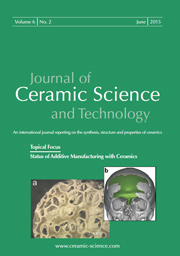Articles
All articles | Recent articles
Ageing Behavior of Injection-Molded ZTA Ceramics as a Function of Stabilizer Content
M. Abou el Ezz1, F. Kern2, R. Gadow2
1 Graduate School of Excellence for Advanced Manufacturing Engineering, Stuttgart University, Institute for Manufacturing Technologies of Ceramic Components and Composites, Allmandring 7 b, D-70569, Germany
2 Stuttgart University, Institute for Manufacturing Technologies of Ceramic Components and Composites, Allmandring 7 b, D-70569, Germany
received July 13, 2011, received in revised form September 19, 2011, accepted October 21, 2011
Vol. 2, No. 4, Pages 191-196 DOI: 10.4416/JCST2011-00025
Abstract
ZTA (zirconia-toughened alumina) ceramics are interesting materials for biomedical implants. High-quality implants are currently produced by means of cold isostatic pressing. The production of ZTA ceramic components by injection molding enables their mass production and an improvement in the cost and quality of complex near-net-shaped ceramic components. Injection-molded and hot-pressed ZTA materials with 10 vol% zirconia stabilized with 0, 1.5 and 3 mol% yttria were prepared and aged in an autoclave in water vapor at 134 °C for up to 48 h, corresponding to ∼ 175 years in vivo. The phase compositions of the aged samples were examined by means of X-ray diffraction. In both experiments, it was shown that the ageing resistance of ZTA materials rises significantly with increasing stabilizer content. Compared to injection-molded and pressureless-sintered materials, fully dense hot-pressed ZTAs have shown improved long-term ageing stability. The ageing behavior of ZTA is obviously dependent on the forming process, relative density and yttria content.
![]() Download Full Article (PDF)
Download Full Article (PDF)
Keywords
ZTA, ceramic injection molding, ageing behavior, mechanical properties
References
1 Casellas, D. et al., Fracture toughness of alumina and ZTA ceramics: microstructural coarsening effects, J. Mater. Process. Tech., 148 – 152, (2003).
2 Becher, P.F.: Slow crack growth behaviour in transformation-toughened Al2O3-ZrO2 (Y2O3) Ceramics, J. Am. Ceram. Soc., 66, [7], 485 – 488, (1983).
3 Chevalier, J., Deville, S., Fantozzi, G.: Nanostructured ceramic oxides with a slow crack growth resistance close to covalent materials, Nano. Lett., 5, (7), 1297 – 1301, (2005).
4 Deville, S., Chevalier, J., Gremillard, L.: Influence of surface finish and residual stresses on the ageing sensitivity of biomedical grade zirconia, Biomaterials, 27, 2186 – 2192, (2006).
5 Rahaman, M.N., Yao, A., Bal, B.S., Garino J.P., Ries, M.D.: ceramics for prosthetic hip and knee joint replacement, J. Am. Ceram. Soc., 90, [7], 1965 – 1988, (2007).
6 Yasuda, K., Arai, S., Itoh, M., Wada, K.: Influence of Y2O3 Distribution on the rate of tetragonal to monoclinic phase transformation of yttria-stabilized zirconia during hydrothermal ageing, J. Mater. Sci., 34, 3597 – 3604, (1999).
7 Marro, G.F., Mestra, A., Lamghari, M., Anglada, M.: Weibull characterization of the flexural strength of hydrothermally degraded 3Y-TZP zirconia in: Proceedings of 12th European Inter-Regional Conference on Ceramics, University of Mons, Mons, Belgium, (2009).
8 Chintapalli, R., Valle, J., Mestra, A., Anglada, M.: Influence of hydrothermal degradation on wear behaviour of zirconia tetragonal polycrystals doped with 3 % molar of yttria, Anales Mecánica de la Fractura, 26, [1], 86 – 91, (2009).
9 Schneider, J., Begand, S., Kriegel, R., Kaps, C., Glien, W., Oberbach, T.: Low-temperature ageing behaviour of alumina-toughened zirconia, J. Am. Ceram. Soc., 91, [11], 3613 – 3618, (2008).
10 Burger, W., Richter, H.G.,: High strength and toughness alumina matrix composites by transformation toughening and "in situ" platelet reinforcement (ZPTA), Key Eng. Mat., 192 – 195, 545 – 548, (2001).
11 Chevalier, J., Gremillard, L.: Ceramics for medical applications: A picture for the next 20 years, J. Eur. Ceram. Soc., 29, [7], 1245 – 1255, (2009).
12 Chevalier, J., Gremillard, L., Virkar, A.V., Clarke, D.R.: The tetragonal-monoclinic transformation in zirconia: Lessons learned and future trends, J. Am. Ceram. Soc., 92, [9], 1901 – 1920, (2009).
13 Gregori, G., Burger, W., Sergo, V.: Piezo-spectroscopic analysis of the residual stresses in zirconia-toughened alumina ceramics: The influence of the tetragonal-to-monoclinic transformation, Mater. Sci. Eng., A271, 401 – 406, (1999).
14 De Aza, H.A., Chevalier, J., Fantozzi, G., Schehl, M., Torrecillas, R.: Slow-crack-growth behavior of zirconia-toughened-alumina ceramics processed by different methods, J. Am. Ceram. Soc., 86, [1], 115 – 20, (2003).
15 Luo, J., Yi, Z., Xiao, B., Gao, Y., Xie, Z., Li, J., Huang, Y.: Injection molding of ultra-fine zirconia (Y-TZP) powders, J. Ceram. Processing Res., 7, [1], 14 – 19, (2006).
16 Kern, F., Abou El-Ezz, M. A., Gadow, R.: Thermoplastic ceramic injection molding of zirconia toughened alumina components, in Advanced Processing and Manufacturing Technologies for Structural and Multifunctional Materials IV: Ceramic Engineering and Science Proceedings, Vol. 31, John Wiley & Sons, Inc., Hoboken, NJ, USA, (2010).
17 Chevalier, J., Gremillard, L., Deville, S.: Low-temperature degradation of zirconia and implications for biomedical implants, Annu. Rev. Mater. Res., 37, 1 – 32, (2007).
18 Niihara, K.: A fracture mechanics analysis of indentation-induced palmqvist crack in ceramics, J. Mater. Sci. Lett., 2, 221 – 223, (1983).
19 Toraya, H., Yoshimura, M., Somiya, S.: Calibration curve for qualitative analysis of the monoclinic tetragonal ZrO2 system by x-ray diffraction, J. Am. Ceram. Soc., 67, [6], C119 – C121, (1984).
20 Deville, S., Chevalier, J., Fantozzi, G., Bartolomé, J.F., Requena, J., Moya, J.S., Torrecillas, R., Díaz, L.A.: Low-temperature ageing of zirconia-toughened alumina ceramics and its implication in biomedical implants, J. Eur. Ceram. Soc., 23, 2975 – 2982, (2003).
Copyright
Göller Verlag GmbH


